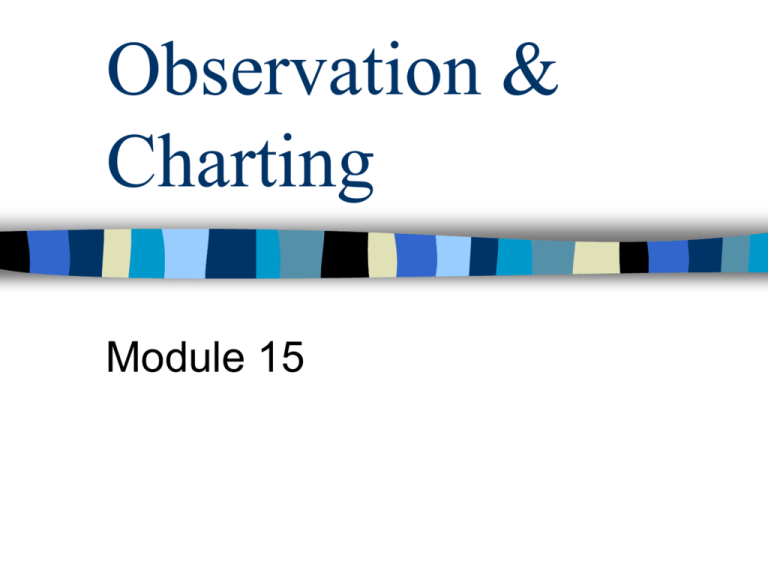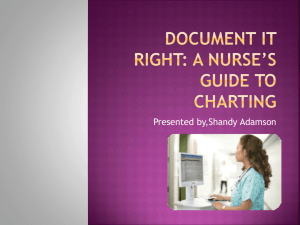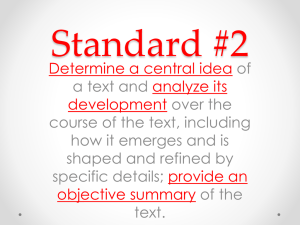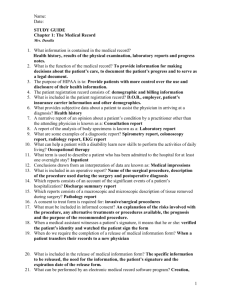Observation & Charting
advertisement

Observation & Charting Module 15 Observation Use of senses to collect information – Senses • • • • Sight Touch Hearing Smell Observations that should be made Skin color & temp Mood & mental status Behavior & movement Unusual odors Respirations Responsiveness Appetite Ability to perform ADLs Elimination Pain or discomfort Observation Learn to observe through daily contactsnote any changes or needs & REPORT ABCs of observation – Appearance – Behavior – Communication Observation Objective – Signs that you can see, hear, feel, smell – Factual, measurable, & observable Subjective – what the resident or family tells you – Not directly seen or observed by CNA – Symptoms reported by resident Types of Charting Documents Resident Record & Chart – Communicates & records health history, status, & treatment – Legal record Kardex – Summarizes dr’s orders – Identifies critical data – allergies, code status, diet, activity, etc. – Gives medication & treatment info Types of Charting Documents Nursing Care Plan – Lists resident’s need & provides specific nursing activities that address needs – Guide for the CNA providing care Graphic sheet – VS, I & O, Weight ADLS sheet – Documents care at each shift for ADLs – Record on which most facilities have the care work chart Charting Procedures Correct chart or ADL sheet Write legibly & neatly – Write notes on paper first – Check for spelling & accuracy Place events in proper sequence Chart according to facility standards Be concise, use appropriate terms & abbreviations Always use ballpoint pen – black ink – No felt tip, fountain pens, pencils, gel pens – Use color only if approved by facility Charting Procedures (cont) Errors – cross out, one line – DO NOT ERASE OR USE WHITE OUT – Write “error” above the line – Initial the entry Include resident’s complete info on each page – Some facilities have imprint stampers – If no stamper, write in name & info Never skip lines Signature, B. McGrory, CNA Charting Procedures (cont) Always date & time entries Make sure you are charting on correct date & time Chart only procedures YOU have performed Never chart for someone else Chart only AFTER you have performed the procedure Charting Procedures (cont) Chart only observations you know to be true (objective data) – Do not chart opinions – Subjective data must be in “quotation marks” & exactly as stated Computers & Charting Basic principles – confidentiality & privacy Systems are password protected – Each user has a personal password – Never share passwords – Sharing/using others’ passwords may be grounds for termination Legal Issues of Charting Resident record is a legal document – Can be used in a court of law All information in chart is confidential Information should be accurate, objective, & truthful Have access only to charts of the resident you are caring for Summary of Charting Guidelines Safety – Note safety measures done to protect him from harm. – Restraints – type, exact time in & out, activity done when in restraint, condition of skin, resident’s response to care given Charting Guidelines Emotions – Mood – angry, withdrawn, crying, etc. – Unusual symptoms showing anxiety – picking at sheets, stuttering, tenseness, restlessness, VS changes – Quotes “I’m afraid” – What decreases anxiety – Changes in orientation Charting Guidelines Range of Motion – Active vs. passive – Problem areas – pain or restricted movement – Progress made Charting Guidelines Positioning – Time of position changes – Observation of skin condition – Reddened areas & what treatment given – How resident tolerated position Charting Guidelines Pressure Sores – Factual observations – location, condition – Special treatment used – positioning, special equipment Charting Guidelines Personal hygiene – Type of treatment or care given (bath, grooming, back care, lotion, make-up) – Why care was NOT given – Skin, mouth, hair, nails, feet descriptions – What resident can do for self – Emotional state – use own words – C/o pain, discomfort – Observe any previous problem area & make a factual statement of current condition Charting Guidelines Nutrition & Fluid – – – – – – – Amount of food eaten (percentage) Type & amount of food NOT eaten Appetite Self feed vs. fed Problems with eating Special diets Intake record for residents with catheter or on bladder training – Weekly or monthly weight Charting Guidelines Elimination – Record urine color, odor, amount, clarity, presence of sediment, mucus – Time of voiding if more freq than every 2 hours – Stool size,number, & characteristics – Unusual occurrences – bright red blood, mucus, dark or strong-smelling urine, burning, voiding small amounts, smeary or liquid feces – Estimating incontinence • • • • 9 in. diameter – 50 –75 cc 12 in. diameter – 100 –125 cc 18 in. diameter – 150 –175 cc 24 in. diameter – 200 –300 cc Charting Guidelines Vital Signs – Febrile vs. afebrile – Pulses – strong, regular, weak, irregular, thready – Respirations – regular, shallow, deep, irregular, Cheyne-Stokes, dyspnea, orthopnea, apnea – Blood pressure – strong, poor, HTN, hypotension Charting Guidelines Oxygen – Exact times on/off O2 – How O2 administered – Number of liters flow per minute – Resident condition & comfort – Care given to prevent irritation to skin, nose, mouth Charting Guidelines Death – Exact time of death & what observations you made – Postmortem care – time & date body was taken to mortuary or morgue. Record what was done with resident valuables & have a witness co-sign. Medical terminology & Abbrev Abbreviations are – Shortened form of words/phrases – Commonly used in health care – Designates medical specialty areas – ER, OR, OB – Shortened forms of word or first letters – amb, BRP, lab, etc – Shortened form of Latin or Greek word – ad lib, prn, po, etc. Abbreviations Drsg Dx ECG EEG ER F FBS FF Fld Ft Gal GI Hr or h H20 HS ht Abbreviations Ht ICU In I&O IV L Lab Lb Liq LLQ LMP LVN Lt LUQ Meds MN Abbreviations Min ml NA CNA Neg Nil Noc NPO O2 OB OJ OOB OR OT Oz pc Abbreviations Peds Per PM po Postop Preop Prep Prn Pt PT Q qd qh qhs qid qod Abbreviations R RLQ RN ROM RR RUQ S SSE Stat Tbsp tid TLC TPR U/A VS WBC Abbreviations W/c tsp Wt 24 hour clock Greenwich time vs. Military time One value for each minute of the day Expressed in 4 digits No colon Midnight can be expressed as 0000 or 2400 24 hour clock 12 MN 0000 2400 6:00 AM 0600 1:00 AM 0100 7:00 AM 0700 2:00 AM 0200 8:00 AM 0800 3:00 AM 0300 9:00 AM 0900 4:00 AM 0400 10:00 AM 1000 5:00 AM 0500 11:00 AM 1100 24 hour clock 12:00 PM 1200 6:00 PM 1800 1:00 PM 1300 7:00 PM 1900 2:00 PM 1400 8:00 PM 2000 3:00 PM 1500 9:00 PM 2100 4:00 PM 1600 10:00 PM 2200 5:00 PM 1700 11:00 PM 2300 24 hour clock Each value has one hour value & one minute value – 5:03 a.m. = 0503 – 5:03 PM = 1703 – 11:57 AM = 1157 – 11:57 PM = 2357 – 12:00 midnight = 2400 or 0000 – 12:05 AM = 0005





